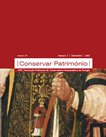 |
António João Cruz, "Imagens em transformação: os painéis da igreja de Santa Maria, de Tavira, encontrados na ermida de São Pedro, e os problemas colocados pelo seu restauro e estudo laboratorial", Conservar Património, 2, 2005, pp. 29-53, doi:10.14568/cp2_4 |
|
⯇ | ⯈ |
| Resumo |
Quatro pinturas do século XVI, agrupadas em dois dípticos, foram encontradas em 1949 numa igreja em Tavira. A partir de então desenrola-se um complexo processo, aqui reconstituído, que leva à detecção de outras pinturas subjacentes e à realização de sondagens que, numa das obras, envolvem a remoção de um terço da pintura visível. Em 1961 é decidido o levantamento integral das pinturas do século XVI de forma a ficarem visíveis as pinturas "Mais" antigas, do século XV. Não obstante as recomendações da literatura disponível na época, a situação não parece ter sido cuidadosamente discutida, tendo sido profundamente condicionada pela ideologia do Estado Novo. No entanto, por razões desconhecidas, esse levantamento só vem a ser efectuado em duas pinturas enquanto nas outras duas são mantidas as imagens do século XVI e são refeitas as áreas destruídas pelas sondagens. Desta forma, o conjunto e a unidade que este apresentava foram desfeitos pela intervenção de restauro, concluída cerca de 1964. Entretanto, as pinturas são radiografadas em três ocasiões (1950, 1955-1960 e 1995), mas, ao contrário do esperado, são obtidas diferentes informações de cada vez. Duas análises da madeira do suporte (cerca de 1961 e 1995) conduzem também a diferentes resultados. Portanto, trata-se de um caso que também põe em evidência algumas limitações dos estudos laboratoriais das obras de arte e a necessidade de os resultados serem interpretados com precaução e espírito crítico. |
| Title |
Changing images: the panels of Saint Mary church, at Tavira, founded at the chapel of Saint Peter, and the problems raised by its restoration and scientific study |
| Abstract |
Four paintings of the 16th century, grouped in two diptychs,were found in 1949 in a church at Tavira (Portugal). Since then, a complex process took place, herein reconstituted, that led to the detection of older underlying paintings on all the four panels and to the removal of the paint layers in some areas that, in one of the works, involved the elimination of one third of the visible painting. In 1961, it was determined the integral removal of the 16th century paintings so that the oldest paintings, from the 15th century, would become visible. In spite of the recommendations in the literature available at that time, the situation does not seem to have been carefully discussed and was deeply conditioned by the ideology of the Estado Novo dictatorial regime. However, for unknown reasons, the complete removal of the pictorial layers was carried out only in two of the panel paintings, while in the other two the 16th century images were kept and the test areas that had been removed were reconstructed. Consequently, the group and its stylistic unity were destroyed by this intervention, which lasted until about 1964. Meanwhile, radiographs of the paintings were taken at three occasions (1950, 1955-1960 and 1995), but, unlike what was to be expected, the information provided differed each time.Two analyses of the wood support (about 1961 and 1995) also led to differing results.Therefore, this case also puts in evidence some limitations of the scientific studies of works of art and the need for precaution and critical mind in the interpretation of the obtained results. |
| Editora |
URL |
| Ver |
PDF |
| |
Academia | Researchgate |
| Importar |
RIS | Endnote |
